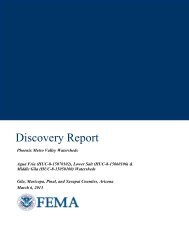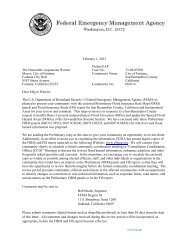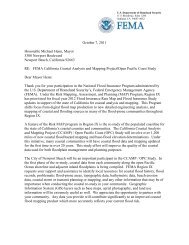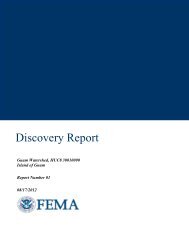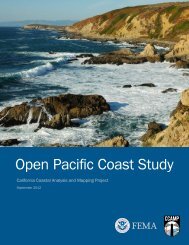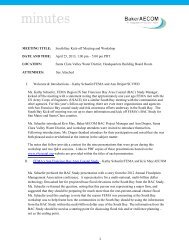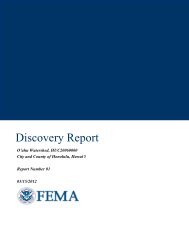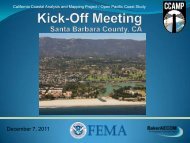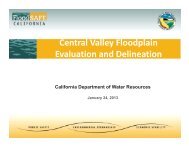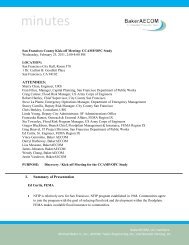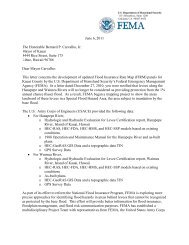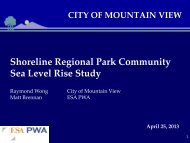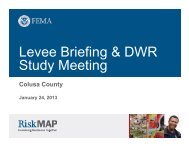YAVAPAI COUNTY, ARIZONA Federal Emergency ... - FEMA Region 9
YAVAPAI COUNTY, ARIZONA Federal Emergency ... - FEMA Region 9
YAVAPAI COUNTY, ARIZONA Federal Emergency ... - FEMA Region 9
You also want an ePaper? Increase the reach of your titles
YUMPU automatically turns print PDFs into web optimized ePapers that Google loves.
approximately 1,600 feet downstream of the former basin and has a 1-percent<br />
annual chance stillwater elevation of 3,492.1 feet (Cooper Arial Surveys, 1978).<br />
For some of the studies in the City of Prescott, flood-frequency data were<br />
developed from discharge-frequency relationships of historic floods and<br />
hydrologic study analyses performed by tile USACE (USACE, October 1973).<br />
Various modifying factors were applied in developing the discharge frequency<br />
curves to allow for the effects of existing floodplain developments.<br />
Flood hydrographs were developed using unit hydrograph procedures. The unit<br />
hydrograph was derived from synthetic S graphs as determined from<br />
reconstitution in the basin or a similar graph.<br />
Peak discharge values for Willow Creek Tributary and Willow Creek Reservoir<br />
Tributary were determined utilizing the NRCS Method. This method is<br />
recommended for drainage basin parameters such as drainage basin area, slope,<br />
vegetation type and cover density, and hydrologic soil groups to determine the<br />
rainfall-runoff relationship and the peak discharge for each recurrence interval.<br />
On Willow Creek, the discharges have been reduced at several points upstream of<br />
the mouth in accordance with the NRCS TR-20 model prepared by Henningson,<br />
Durham & Richardson, Inc.<br />
Discharges for the Agua Fria River, Navajo Drive Wash, and Lynx Creek in the<br />
Town of Prescott Valley were developed using the computer program Project<br />
Formulation Hydrology (<strong>FEMA</strong>, 1964). This NRCS methodology uses basin<br />
physical characteristics, soil classification, cover conditions, and precipitation<br />
amount as parameters for developing runoff.<br />
A hydrologic analysis for North Navajo Drive Wash was done by adjusting the<br />
discharge values of previously studied Navajo Drive Wash (<strong>FEMA</strong>, 1982, revised<br />
1990), by applying the drainage area ratio. The peak 1-percent annual chance<br />
discharge varies from 190 cubic feet per second (cfs) upstream to 740 cfs<br />
downstream. For this study only the 1-percent annual chance flood was<br />
calculated.<br />
The upper Agua Fria River watershed basin was divided into subwatersheds, with<br />
attention given to homogeneity of soil type and cover conditions. Times of<br />
concentrations were computed using Manning's equation to develop the velocity<br />
component. Drainage areas were measured using USGS topographic maps (U.S.<br />
Department of the Interior, 1965, et cetera; U.S. Department of the Interior, 1947<br />
et cetera; U.S. Department of the Interior, 1970).<br />
Soil classification and cover conditions were determined through field surveys<br />
and through the General Soil Map for Yavapai County (U.S. Department of<br />
Agriculture, 1978). Antecedent moisture condition 2 was used for the soil<br />
moisture content.<br />
Tile National Oceanic and Atmospheric Administration Atlas 2 (USACE,<br />
February 1977) was used to select rainfall amounts for the 10-, 2-, and 1-percent<br />
24




